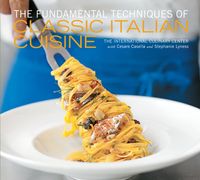Advertisement
Rolling and Cutting Dough for Noodles
Stendere e Tagliare la Pasta
In this curriculum, students roll the dough with a pasta machine. Unless making filled pasta, it is practical to roll all of the dough through each setting before moving to the next setting. While rolling, if the strips get too long to manage comfortably, they are cut in half, or into smaller segments, and worked one segment at a time. A bowl of bench flour is kept on the side of the workstation, so that dough may easily be sprinkled with flour if it feels sticky. In order to prevent clumps of flour being rolled into the dough, excess flour is always brushed off the dough sheets after sprinkling. To hold the finished rolled and cut pasta, sheet pans are lined with parchment paper, and sprinkled with semolina to prevent sticking.

